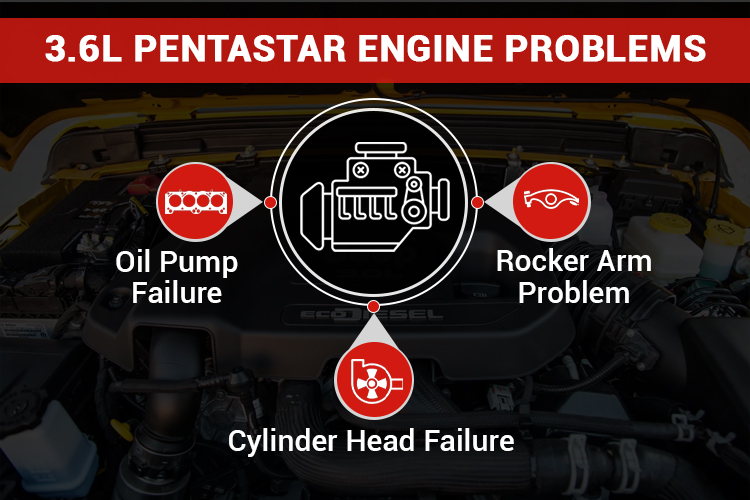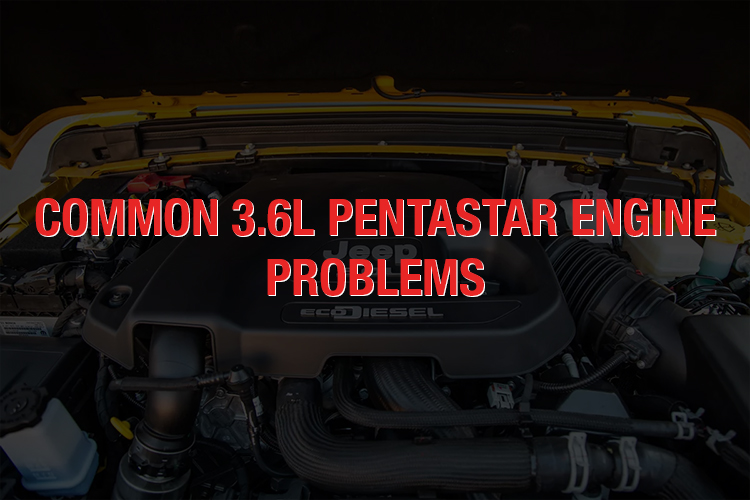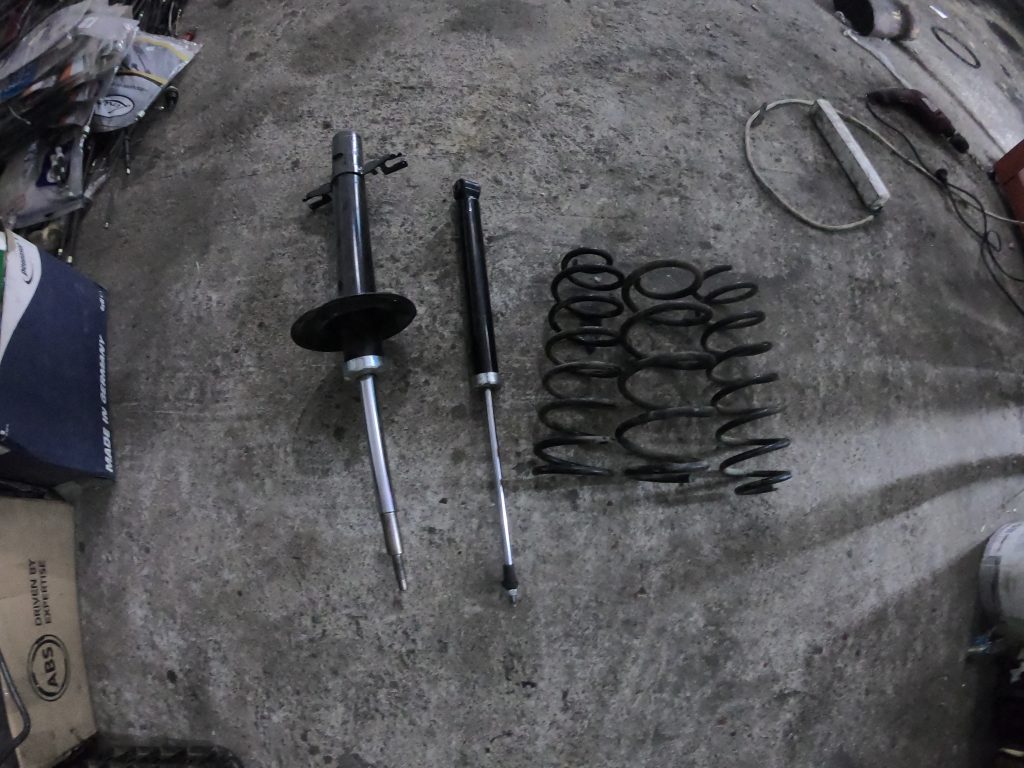The Pentastar has been powering several luxury and high-performance cars since 2011 when it was first available in vehicles. However, even through years of trying to achieve consistency, the engine has faced several problems.
However, every problem has a solution, and this article tackles the three most common 3.6L Pentastar engine problems and their solutions.
Be our guest.
What is the 3.6L Pentastar Engine?
The 3.6L Pentastar is a six-cylinder engine from Chrysler, a renowned car manufacturer.
It is among the most technologically advanced and versatile powertrains, evident from its construction and innovation.
The V6 engine has been around since 2011, serving numerous high-end vehicles with consistent solid performance.
It comes with a six-cylinder configuration, and its output is around 275-303hp.
What Cars Use the 3.6L Pentastar?
The 3.6L Pentastar is used in the following cars:
| Chrysler 3.6L Pentastar | Dodge 3.6L Pentastar | Jeep 3.6L Pentastar | Ram 3.6L Pentastar |
| 2011-2017 Chrysler 200 | 2011-2014 Dodge Dodge Avenger | 2011- present Jeep Grand Cherokee | 2012- present Ram 1500 |
| 2011- present Chrysler 300 | 2011- present Dodge Carger | 2012-2018 Jeep Wrangler | 2012- Ram ProMaster |
| 2011-2016 Chrysler Town and Country | 2011- present Dodge Challenger | 2011-2015 Ram Cargo Van | |
| 2016- present Chrysler Pacifica | 2011- present Dodge Durango | ||
| 2020- present Chrysler Voyager | 2011-2019 Dodge Journey | ||
| 2011-2020 Dodge Grand Caravan |
Most users have reported having a great experience with the 3.6L Pentastar. That only comes with great maintenance.
Thus, the engine is known to go for over 200,000 miles without experiencing any complicated issues.
However, we’ve had cases of some users hitting the 500,000-mile mark without encountering any problems.
3.6L Pentastar Engine Problems

However, every engine will develop problems like every other engine out there.
Here is a roundup of the most common 3.6L Pentastar problems you might experience and their solutions.
1. Rocker Arm Problems
Rocker arm problems are mostly mistaken for cylinder head failure problems because they affect the same engine unit: the cylinder heads.
That is because the rocker arms are found within the cylinder heads.
However, rocker arms are different from cylinder heads, and they need to be treated with a different approach.
Symptoms
Here are the signs to look out for to determine if your engine has broken rocker arms.
- Engine ticking
- Engine misfires/stalling
- ‘Check Engine’ light on
- Noticeable Rocker Arm damage
- Diagnostic Trouble Code (DTC)
Of the three, the most common is the engine ticking sound on the engine’s upper area.
Additionally, you may receive trouble codes relating to the same when running diagnostics that may indicate engine misfires.
Or, in some cases, some other symptom related to rocker arm problems.
Cause
There are a few known causes of rocker arm failure, and they include;
- Incompatible or bad fuel. Bad fuel causes the engine to misfire, which ends up damaging your cylinders’ rocker arms.
- Continuous usage of contaminated or wrong type of oil. That is why professionals recommend changing the oil at intervals, ensuring it is of the correct type.
- Engine overheating
- Bad timing chain or belt
- Long drives on an unmaintained engine
- Broken or bent valves
Solution
When you experience rocker arm failure, you are advised to do a replacement to solve the problem.
However, the process is complex and needs either experienced DIYers or professionals.
Again, all rocker arms seem to fall out of place simultaneously. Therefore, you need to replace all of them at once.
Rocker arm kits (including all other useful components like pushrods and guide plates) cost around $100-$500, depending on the type of car.
Therefore, hiring a professional for the job might cost you around $500-$1,500 for both parts and labor.
Even though the figures might seem huge for some, it is cheaper than waiting to replace the whole engine later.
2. Cylinder Head Failure
Most engines suffer from cylinder head problems, and the 3.6L Pentastar is not an exception.
However, the problem is prominent in 2011-2013 engines but regularly shows up in the rest.
It is, therefore, fitting to talk about its symptoms, causes, and possible solutions.
Symptoms
Here are some of the things that will notify you of cylinder head problems;
- Engine misfires
- Significant loss of power
- ‘Check Engine’ light
- Constant engine ticking
- Smoke from the exhaust
- Drop in oil levels
- A significant drop in engine performance
If you’re getting any of these symptoms or a combination of any of them, consider having your engine checked for cylinder head complications.
Cause
The most common cause of cylinder head failures is overheating. Overheating can be caused by;
- Coolant loss
- Restricted coolant flow
- Head gasket failure
In extreme cases, cylinder head failures can be brought about by a cracked or damaged cylinder head. However, this risks damage to the entire engine!
Solution
If your cylinder head is broken, you should find a replacement. It is the easiest, quickest, and most hassle-free solution.
Cylinder replacement on the 3.6L Pentastar is expensive. However, you don’t have to worry if your car is under warranty.
Cylinder head failure on the 3.6L Pentastar can occur in any model year but is not common in the most recent years.
3. Oil Pump Failure
Among the discussed problems, this is the least possible to occur.
However, when the problem shows up, it leads to the loss of oil, which is the root of other serious engine problems.
On most occasions, oil pump failures are not complete failures but a drop in oil pressure.
Symptoms
As you’d expect, most oil pump failure problems directly relate to your engine’s oil status. They include;
- Low oil pressure
- Noise at the oil pump
- Hydraulic lifter noise
- Check engine oil light
- Increased engine temperature
- Noise from the valve-train system
Cause
There are several major causes of oil pump failure in engines. They include;
- Normal wear and tear – When the cylinder is used for long, it loses its ability to record optimal performance.
- Oil contamination – Dirt, wear particles, or other materials ruin your oil pump in the long run.
- Low oil level – When you keep driving your vehicle with low engine oil, you’re exposing it to excessive friction, which might lead to damage to the oil pump.
- Engine sludge – Engine sludge is a combination of old oil and dirt, which is highly dangerous to a vehicle’s mechanical parts. The oil pump isn’t spared either.
- Poor maintenance – Good maintenance will mostly eradicate all engine problems.
Solution
Regularly filling oil to the correct level is a temporary fix to oil pump problems. However, addressing oil leaks and burning oil issues would be best.
Again, according to the cause of the oil pump problem, you might need to replace your oil filter or perform a complete oil cleaning (replacement).
Conclusion
The 3.6L Pentastar is a quality engine that has earned the trust of quality and high-performance cars and SUVs in the past decade.
However, the engine is faced with several problems that lower its productivity.
However, these problems are easy to solve, and you’ll be back on the road better and stronger!





